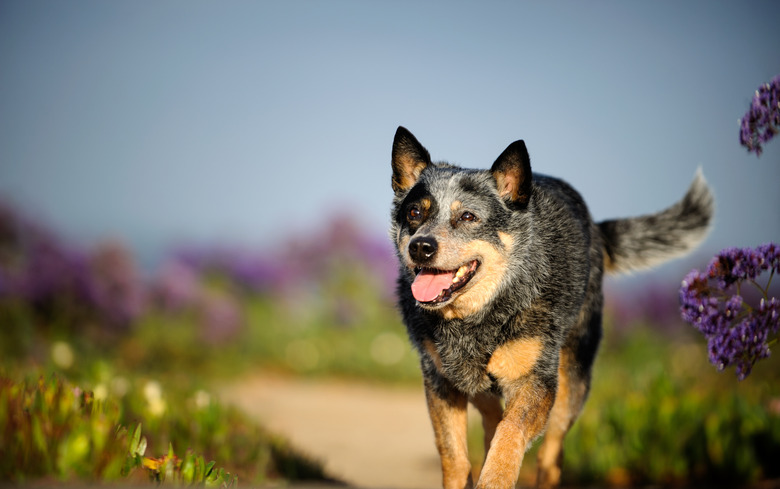Blue Heeler (Dog): Size, Characteristics & Temperament
An energetic blue heeler is an ideal dog for an active person or family. Originally bred to work on Australian cattle ranches, the blue heeler particularly enjoys spending time outdoors. Nineteenth-century Australian cattle ranchers were unhappy with the dogs they brought with them from England and realized they needed tough dogs that could handle the extreme heat and cold in the outback. They bred dingoes with collies and other dogs to create a breed that could endure long days herding wild cattle.
Today, blue heelers are still used to herd animals. The breed is formally called the Australian cattle dog, but the dogs are also known as blue or red heelers, depending on the coat color, or Queensland or Australian heelers. Keeping this active dog busy is the key to happiness for him and you. You might see their name spelled as "blue healers" but that's a misspelling — they got their name by being bred as a dog to herd cattle by nipping at their heels.
Blue heeler characteristics
Blue heeler characteristics
The American Kennel Club first registered blue heelers in 1980 and classifies the breed as a part of the herding group. Blue heelers have long, sturdy bodies, pointed ears, rounded heads, and strong legs and necks. Their short outercoats help them tolerate wet conditions, while the thicker undercoats provide protection from cold temperatures. Hair color can vary along the shaft of the hair, giving them a speckled appearance.
Blue heelers weigh approximately 35 to 50 pounds. Females are 17 to 19 inches tall at the shoulders and males are slightly taller, reaching 18 to 20 inches tall.
Blue heeler temperament & training
Blue heeler temperament & training
Blue heelers aren't lap dogs and don't enjoy long, leisurely naps in the sun. They were bred to work, and if you don't find something for them to do, they might just decide to help you by herding your family members or pets. If you don't offer them enough exercise and activities, they can be destructive. Herding dogs direct wayward cattle with their mouths and can nip or bite people or other animals when playing or herding.
Obedience training classes and early socialization will help them learn appropriate behavior. Keep these intelligent dogs busy and engaged by enrolling them in an activity such as agility training classes. The AKC notes that the blue heeler personality may be a bit stubborn, so be prepared to be patient and positive during the training process. These dogs often form a particularly strong attachment to one person, although they will be protective of the entire family.
Blue heeler grooming
Blue heeler grooming
Unlike many other dogs, blue heelers don't shed continuously. Instead, the hair in their undercoats falls out in clumps once or twice each year. While blue heelers are shedding, they need a daily brushing but for the rest of the years, brushing them once per week is sufficient.
Blue heeler exercise & health
Blue heeler exercise & health
Blue heelers are very high-energy dogs and they need plenty of daily exercise. A blue heeler can be a family dog if you have the time and energy to take them on long daily walks and play games of fetch and Frisbee. Make sure your yard is fenced, as blue heelers enjoy roaming if given the chance.
Blue heelers are prone to developing hip dysplasia, a condition that occurs when the thighbone doesn't fit into the hip properly, due to joint abnormalities. This painful condition can lead to lameness and arthritis. Some dogs develop progressive retinal atrophy, a condition that gradually leads to severe vision loss. Blue heelers may be born deaf.
All of these problems can be avoided if breeders follow recommended guidelines and don't breed dogs with these conditions. Reputable breeders can provide health certificates that show that the parents have been examined and don't have any of the conditions common in the breed. The AKC notes that hip and elbow X-rays can eliminate the possibility of dysplasia. A DNA test can determine if either of the parents has progressive retinal atrophy.
Blue heeler puppies
Blue heeler puppies
Blue heeler puppies should be kept with their mother and littermates until they are at least 7 to 8 weeks old. This gives them the time necessary to learn social skills such as bite inhibition. While owners will need to continue socialization and training, this time is critical for the pup.
Blue heelers typically reach their full size when they are 14 to 16 months old. At three months old, females are generally 12.9 and 14.3 pounds and males are 13.8 and 14.3 pounds. By six months of age, their weight may double with females weighing an average of 23.6 pounds and males an average of 25.3 to 26.3 pounds.
